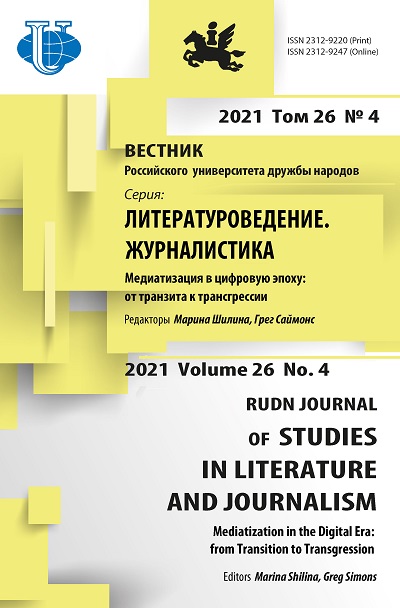A Parodic Tale in “Sovy” (Soviet Texts) by D. Prigov
- Authors: Romanovskaya O.E.1
-
Affiliations:
- Astrakhan State University
- Issue: Vol 26, No 4 (2021): MEDIATIZATION IN THE DIGITAL ERA: FROM TRANSITION TO TRANSGRESSION
- Pages: 771-780
- Section: LITERARY CRITICISM
- URL: https://journals.rudn.ru/literary-criticism/article/view/29870
- DOI: https://doi.org/10.22363/2312-9220-2021-26-4-771-780
- ID: 29870
Cite item
Full Text
Abstract
The article aims to study D. Prigov’s series of prose texts “Sovy” (Soviet texts) artistic subtleties as a conceptualist work. The author of the article analyzes genre and style modifications owing to use of parodic stylization. The research exemplifies how a fairy tale, epic, legend, anecdote, hagiography are modified by the Soviet myth content, whereas creating a quasi-history. Historical characters, politicians, poets and writers, mythologized by ideology and commonplace consciousness in the “Sovy”, are presented as cultural and progenitor heroes. Life journey of characters, cultivated by the Soviet myth, is often depicted according to the hagiographic canon. The mask of a storyteller/propagandist is the starting point of folklore stylizations and parody imitations of the Soviet art in the “Sovy” series. Parodic tale was crafted by mimicking folklore and journalistic styles, their hybridization at the lexical-grammatical and rhythmic-syntactic levels. Styles, genres and masks mocking in D. Prigov’s “Sovy” series is examined at the methodological perspective of text narratological analysis for the first time, thus emphasizing the study’s novelty and relevance. The author of the article concludes that D. Prigov deconstructs Soviet mythologems, showcasing transformations of a myth to an anecdote, a famous name into an empty sign, a story into a simulacrum.
About the authors
Olga E. Romanovskaya
Astrakhan State University
Author for correspondence.
Email: rom.vs.olga@gmail.com
ORCID iD: 0000-0002-7700-5163
Astrakhan State University, Candidate of Philology, Associate Professor of the Department of Literature
21a Tatishcheva St, Astrakhan, 414056, Russian FederationReferences
- Kobrinskij, A.A. (2009). Daniil Harms [Daniil Harms]. M.: Molodaja gvardija. (In Russ.)
- Kozhevnikova, N.A. Tipy povestvovanija v russkoj literature ХIХ–ХХ vekov [Types of narrative in Russian literature of the XIX–XX centuries]. M.: Russian Language Institute, 1994. (In Russ.)
- Kurganov, E.Ja. (2014). Anekdot kak zhanr russkoj slovesnosti. Moscow: Arsis Books. (In Russ.)
- Lipoveckij, M.N. (2008). Paralogii: Transformacii (post)modernistkogo diskursa v russkoj kul’ture 1920–2000-h godov. Moscow: Novoe literaturnoe obozrenie. (In Russ.)
- Lojter, S.M. (2010). Bylina-panegirik, plach-panegirik, skazka-panegirik. Trudy Karel’skogo nauchnogo centra RAN, (4), 154–157. (In Russ.)
- Meletinskij, E.M. (2012). Pojetika mifa. M.: Akademicheskij proekt; Mir. (In Russ.)
- Prigov, D.A. (2016). Moskva. Sobranie sochinenij. Moscow: Novoe literaturnoe obozrenie. (In Russ.)
- Hellman, B. (2006). “Velikij drug detej”. Obraz Stalina v sovetskoj detskoj literature. In Istorija i povestvovanie: sbornik statej (pp. 446–460). Moscow: Novoe literaturnoe obozrenie. (In Russ.)
- Cvigun, T.V. (2014). Odnazhdy v narrativah D. Harmsa. In Vestnik Baltijskogo federal’nogo universiteta im. I. Kanta, (8), 44–48. (In Russ.)
- Shmeleva, E.Ja., & Shmelev, A.D. (2002). Russkij anekdot: Tekst i rechevoj zhanr. Moscow: Jazyki slavjanskoj kul’tury. (In Russ.)
- Jejdel’man O.V. (1999). Legendy i mify Sovetskogo Sojuza. In Logos, 5(15), 52–65. (In Russ.)
Supplementary files















